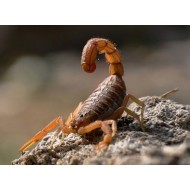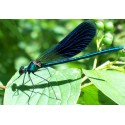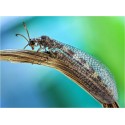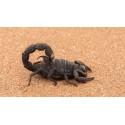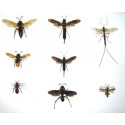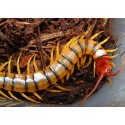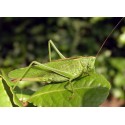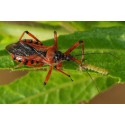OTHER INSECTS
In this section you can find more than 500 different species of insects from Paleartic region for your collection or study.
Some species we have in stock are rare and discontinued but most of them are common beetles that we collect during our trips in Italy and Greece sold for a fair price and many others you find come from exchanges with other ...
In this section you can find more than 500 different species of insects from Paleartic region for your collection or study.
Some species we have in stock are rare and discontinued but most of them are common beetles that we collect during our trips in Italy and Greece sold for a fair price and many others you find come from exchanges with other collegues entomologists from all Europe.
All beetles are sold as A1 ( or A1- when specified ) with full collecting data, sold per single specimen, pairs or lots, they have been professionally collected, mostly hunted in fields or by light-trap, killed with the best methods to keep their legs very soft to be spread and mounted, then well preserved in sealed boxes with Camphor to prevent that pests can ruin them.
Some of these have been collected in tree-traps, pitfall-traps, dungs, these have already been accurately washed and rinsed, no hassles and no need to wash our specimens before you decide to prepare them.
All specimens are sealed in blisters ( cardboard , soft paper, cellophane on top and staples ) to protect them during shipping, some other soft bodied insects, are in tubes under preservant fluids.
Once you receive them , before you start mounting them, these specimens dry in blisters must be soften in humid box to get soft their appendix and legs.
Some beetles, when specified in the listing, can be sent mounted on glue boards ( from ex collections ) JUST GLUED NON PINNED AS WELL , you can keep them ready like this or change softening and removing the glue, soaking in water for some minutes
OTHER INSECTS There are no products in this category.
Subcategories
-
Odonata ( Dragonflies )
Odonata is an order of carnivorous insects, encompassing the dragonflies (Anisoptera) and the damselflies (Zygoptera). The Odonata form a clade, which has existed since the Triassic.
Dragonflies are generally larger, and perch with their wings held out to the sides; damselflies have slender bodies, and hold their wings over the body at rest.
-
Neuroptera
The insect order Neuroptera, or net-winged insects, includes the lacewings, mantidflies, antlions, and their relatives. The order contains about 6,000 species.. Within the endopterygotes, the closest living relatives of the neuropteridan clade are the beetles. The common name lacewings is often used for the most widely known net-winged insects – the green lacewings (Chrysopidae) – but actually most members of the Neuroptera are referred to as some sort of "lacewing".
The adults of this order possess four membranous wings, with the forewings and hindwings about the same size, and with many veins. They have chewing mouthparts, and undergo complete metamorphosis
Neuropterans first appeared during the Permian period, and continued to diversify through the Mesoziod Era .During this time, several unusually large forms evolved, especially in the extinct family Kalligrammatidae, often referred to as "the butterflies of the Jurassic" due to their large, patterned wings.
-
Arachnida
Arachnids are a class(Arachnida) of joint-legged invertebrate animals (arthropods), in the subphylum Chelicerata. All arachnids have eight legs, although the front pair of legs in some species has converted to a sensory function, while in other species, different appendages can grow large enough to take on the appearance of extra pairs of legs. The term is derived from the Greek word aráchnē , meaning "spider". Spiders are the largest order in the class.
Almost all extant arachnids are terrestrial, living mainly on land. However, some inhabit freshwater environments and, with the exception of the pelagic zone, marine environments as well. They comprise over 100,000 named species, including spiders, scorpions, harvestmen, ticks, mites, and solifuges.
-
Hymenoptera
Hymenoptera is the third-largest order of insects, comprising the sawflies, wasps, bees, and ants. Over 150,000 species are recognized,with many more remaining to be described.
Females typically have a special ovipositor for inserting eggs into hosts or otherwise inaccessible places. The ovipositor is often modified into a stinger. The young develop through holometabolism (complete metamorphosis)—that is, they have a worm-like larval stage and an inactive pupal stage before they mature.
-
Myriapoda
Myriapoda is a subphylum of arthropods containing millipedes, centipedes, and others. The group contains over 13,000 species, most of which are terrestrial.
Although their name suggests they have myriad (10,000) legs, myriapods range from having over 750 legs
-
Orthoptera
The Orthoptera order of insects includes the grasshoppers, crickets, cave crickets, Jerusalem crickets, katydids, weta, lubber, Acrida, and locusts
More than 27,000 species are distributed worldwide. Many insects in this order have paurometabolous or incomplete metamorphosis, and produce sound (known as a "stridulation") by rubbing their wings against each other or their legs, the wings or legs containing rows of corrugated bumps. The tympanum or ear is located in the front tibia in crickets, mole crickets, and katydids, and on the first abdominal segment in the grasshoppers and locusts.
These organisms use vibrations to locate other individuals.
Grasshoppers are able to fold their wings, placing them in the group Neoptera.
-
Hemiptera
The Hemiptera /hɛˈmɪptərə/ or true bugs are an order of insects comprising some 50,000 to 80,000 species of groups such as the cicadas, aphids, planthoppers, leafhoppers, and shield bugs. They range in size from 1 mm (0.04 in) to around 15 cm (6 in), and share a common arrangement of sucking mouthparts. The name "true bugs" is sometimes limited to the suborder Heteroptera. Many insects commonly known as "bugs" belong to other orders; for example, the lovebug is a fly, while the May bug and ladybug are beetles.
Most hemipterans feed on plants, using their sucking and piercing mouthparts to extract plant sap. Some are parasitic while others are predators that feed on other insects or small invertebrates. They live in a wide variety of habitats, generally terrestrial, though some species are adapted to life in or on the surface of fresh water. Hemipterans are hemimetabolous, with young nymphs that somewhat resemble adults. Many aphids are capable of parthenogenesis, producing young from unfertilised eggs; this helps them to reproduce extremely rapidly in favourable conditions.
Humans have interacted with the Hemiptera for millennia. Some species are important agricultural pests, damaging crops by the direct action of sucking sap, but also harming them indirectly by being the vectors of serious viral diseases. Other species have been used for biological control of insect pests. Hemipterans have been cultivated for the extraction of dyestuffs cochineal (also known as carmine) and for shellac. The bed bug is a persistent parasite of humans. Cicadas have been used as food, and have appeared in literature from the Iliad in Ancient Greece.
